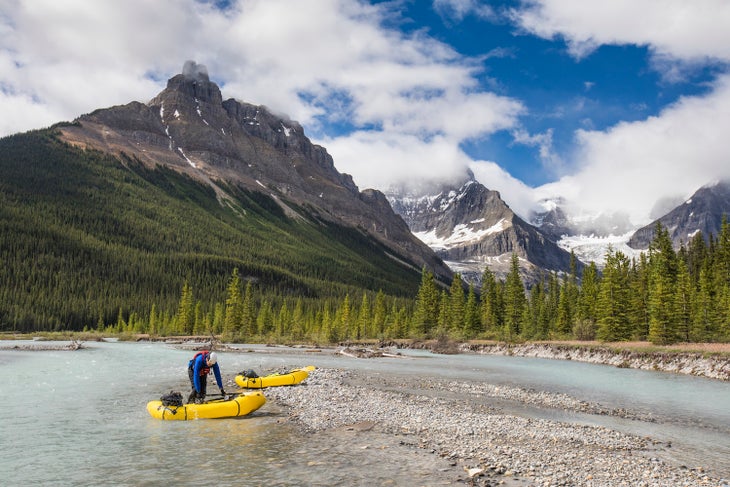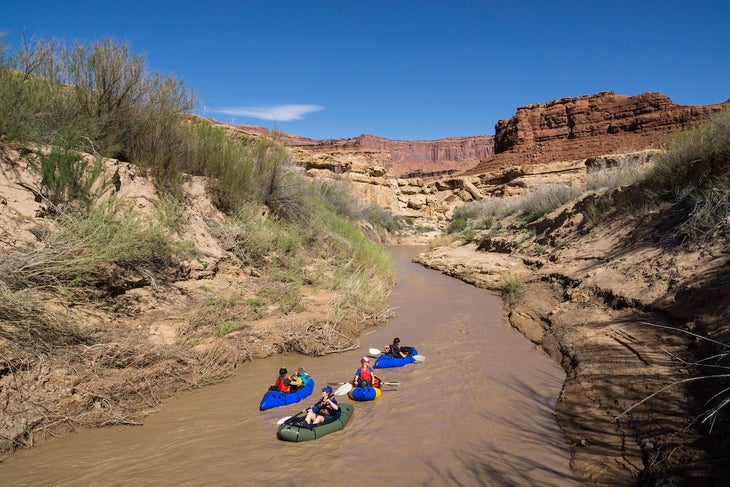Products You May Like
Get full access to Outside Learn, our online education hub featuring in-depth fitness, nutrition, and adventure courses and more than 2,000 instructional videos when you sign up for Outside+
Sign up for Outside+ today.
Personal floatation devices and paddles banged into my shins as I schlepped the last load of gear from the shuttle van and dropped it in the red dust at my feet. That’s when I heard Andrew’s voice cut through the air: “Hey, did anyone grab my packraft?”
I didn’t have Andrew’s raft. Based on the looks Will, Stew, and Kalen exchanged, they didn’t either. Our shuttle driver, having received his payment for the two-hour journey from Moab to the Lathrop Trail on the White Rim Road, made a hasty exit. “Don’t call me!” he yelled before driving away, leaving us with a one-raft deficit in the middle of Canyonlands National Park.
Since they’re lightweight and portable, packrafts are ideal for hiking/paddling hybrid adventures. We wanted these inflatable boats to enable the kind of land-and-water trip we dreamed of, so we set out to link the Green and Colorado Rivers—by boat and foot—through all four districts of Canyonlands on a 50-mile journey over three days. It was an ambitious schedule, but we figured a swift current would do much of the work and our stout constitutions could handle the rest.
But we’d lost a boat. Dauntless, Kalen offered to paddle Andrew in her raft if the rest of us could manage his gear. Stew’s boat was fun-sized and barely fit both him and his pack. That left Will and I to wrangle all of Andrew’s belongings. After lashing down the final item on the bow of my craft, I watched as the stern popped up in the air, forfeiting its battle with physics.

Within minutes, we had a second problem: Where was the current? Based on beta from a park ranger, we’d planned the trip around a 5-miles-per-hour flow rate. Instead, we found a lazy current moving at less than half that speed. His face obscured by a mountain of drybags, I heard Will say, “This is slower than bath water.” We’d never cover 23 miles to Spanish Bottom by sunset.
We paddled through the rest of the day, our red-and-yellow boats meandering through the murky brown water like Skittles floating in chocolate milk. Our new schedule had us arriving at the confluence of the Colorado and the Green Rivers at dusk.
I’d never struggled so much with routefinding on a hiking trip—the packrafts had let us access an area that was unreachable on foot, and in doing so they’d gotten us into trouble. We were stuck a thousand vertical feet below the rim, hours before Stew’s flight home. Our ambitious weekend suddenly felt like a bad idea.
On the last morning, the hipbelt on my pack ripped open the skin on my hips. Blood stained my pants as I struggled up the steep trail, cursing the rubber boat that weighed down my pack.
Eventually, we arrived back at the cars, nine hours late, Stew’s flight from Denver had long departed, and we had traveled only 38 miles of our planned 50-mile route. I’m not sure which fared worse: our feet, coated in dried blood from opened blisters, or our egos, having taken such a massive beating. I’ll call this one a draw. Turns out an adventurous spirit and a tight schedule weren’t the best fit. —Heather Balogh Rochfort

Master the Basics of Packrafting
Multisport voyages take double the preparation. Here’s how to get started.
1. Pack strategically.
With the addition of a raft, your kit will need some rearranging. Cinch paddles and your life jacket to the outside of your backpack, and your boat and camping gear go inside. Leave behind non-essentials; you won’t regret it.
2. Start easy.
Packrafting involves a lot of variables that regular hiking doesn’t. The gear adds around 15 pounds to your back, so plan to hike at half your normal speed. Paddling pace largely depends on the current, but beginners can expect to cover around 2 miles per hour.
3. Get to know your boat.
Practice inflating and deflating your raft at home—it will save time in the field. In addition, getting the hang of paddling on flat water ahead of time will also make your trip smoother.
Get The Most Out of Your Packraft
If you’re looking to get your own packraft, you have some options. You don’t have to settle for anything basic; you can tailor it to your specific priorities.
DIY Packraft
Going packrafting doesn’t mean you have to shell out the hundreds, sometimes thousands, of dollars it costs to get the gear. You can save some money and make a DIY packraft with kits available online. DIY Packraft is a company that sends you the parts, and you assemble it yourself, IKEA-style.
If you are sure you want to craft your own raft, make sure it’s leak-proof, buoyant, and sturdy enough to withstand rugged shorelines. Ultimately, your decision to DIY comes down to your priorities: spending more money and less time on raft construction or less money and more time on raft construction.
Custom-made Packraft
What if you’ve got a little extra spending money and want to optomize your packraft to your own adventure goals? Customize it! If you select a base raft model, Alpacka Rafts and Koaro Packrafts will let you choose your own features such as fabric, color, back rest, and more. That way, you can still enjoy the benefits of a raft suited to your needs without needing to construct your own DIY packraft.
